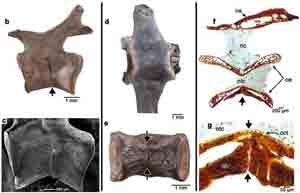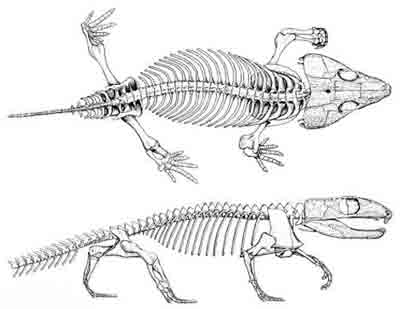Rare Vertebra Fossil Prehistoric Primitive Reptile Cotylosaur Captorhinus aguti mm 1 x 1 Permian Paleozoic Collecting Paleontology Museum.
Caudal fossil vertebra showing an autotomic structure, i.e. the ability to fracture the bone into two pieces so that the animal's tail detaches allowing it to escape a predator.
Difficult to find, good quality intact fossil specimen with appreciable, very well preserved details of the evident suture which allows the central section of the vertebra to be observed. Not restored at all.
In plexiglas box diam. 3 cm, only a piece, as in photos.
Available
at this link 100 g of excellent quality Fossil Sediment from the Lower Permian with many small Paleontological finds, both fragments and intact material of toe bones, jaws, skull plates, teeth, vertebral bodies (intercentra), ends of the bones of arts, etc. Most of the specimens are of prehistoric cotylosaur reptiles such as Captorhinus magnus and Captorhinus aguti.
Autotomy. A recent study revealed that an ancient group of reptiles would be able to "sever" their own tail to escape predators
The captorinids (Family: Captorhinidae) are a group of extinct reptiles with a similar appearance to that of the current lizards, lived between the geological periods of the Upper Carboniferous and Permian, between about 300 and 250 million years ago. These reptiles, being mostly medium-small, had to look for food and avoid being hunted by larger predators, such as large carnivorous amphibians.
As stated by the University of Toronto Mississauga research team, one of the ways in which these animals could escape the danger was to practice the autotomy of the tail, or "lose" this part of the body, similar to what can be observed for evolutionary convergence in many species of modern lizards. To corroborate this hypothesis was the discovery of fragile caudal vertebrae, with vertebral centers characterized by

fissures, similar to cracks. It is probable that these bone cracks were the ones that allowed the vertebrae to break in dangerous situations, for example following a bite of a predator. In particular, paleontologists have observed that these cracks were much deeper in young specimens, whereas in adults they tended to be less marked. This would confirm the hypothesis of autotomy as an anti-predatory strategy, since, similarly to what occurs in current reptiles, even in captorinids, the rate of predation of young individuals had to be much higher than that of adults.
As published in Scientific Reports, to date it seems that the captorinids were the only Permian reptiles to have had a similar defense strategy, so that it may have been the latter the key to their evolutionary success, allowing them to reach a distribution almost global, before extinction at the end of the Permian, around 250 million years ago.
The ability to practice the autotomy of the tail is a trait that at the moment has been observed only in the captorinids and in some groups of more recent lacertides, lived from about 70 million years ago.
Captorhinus is an extinct genus of captorhinid reptiles (Reptilia, Eureptilia, Captorhinida, Captorhinidae, once grouped in the Cotylosauria) that lived during the Permian period. His remains are known from North America, Europe, India and Africa.
Among the different forms of Captorhinus, there are three main species that are the best known:
Captorhinus aguti, Captorhinus magnus and Captorhinus laticeps. C. aguti is the typical species of Captorhinus.
The Captorhinus magnus has so far been identified only by the locality of Richards Spur in Oklahoma, a site that has also produced the remains of C. aguti. C. magnus fossils are found mainly in the deepest regions of the fissure fill complex, while in the upper sediments the remains of C. magnus are extremely rare. This suggests the ecological substitution of C. magnus with the small C. acting during the first Permian.

The skeletal elements of Captorhinus magnus possess an almost identical morphology to those elements of Captorhinus aguti, with the sole exception of the difference in size. Captorhinus magnus averaged about twice as much as C. aguti. Another important difference between the two species is that C. magnus teeth are arranged in a single row.
In 1882, Edward Cope described this finding as Ectocynodon aguti. The name was then reviewed several times by different paleontologists while other genres were discovered. Captorhinus comes from the Latin word "captor", which means "one who catches something" and from the Greek word "rhino" which means "of the nose". This is based on the theory that the typically curved Captorhinus curve could have been used to capture prey.
The
Cotilosaurs (Cotylosauria) are an order of fossil reptiles of the sub-class Anapsida (compact skull reptiles, from which today's turtles derived) whose origin dates back to the Carboniferous. They were the first representatives of the reptile class, characterized by squat body, heavy skull and without windows and short limbs: an aspect generally similar to that of primitive amphibians. At the beginning of their history the cotylosaurs were small animals similar to amphibians, but different from them for numerous characters, including the palate, the cranial vault, the inner ear and the vertebrae; the fundamental character, however, is the formation of the amnios, a membrane that envelops the embryo, which remains in this way immersed in the amniotic fluid. This amniotic egg is fundamental for a better adaptation to terrestrial life, and allows the reptile to reproduce itself outside the aquatic environment to which most amphibians were bound.
Appeared in the upper Carboniferous Era of the Paleozoic Era, at the beginning of the Permian period the cotilosaurs developed and prospered, diversifying into many species of various shapes and sizes. Among the main groups to remember the protorotirididi, the most ancient, similar to lizards (including Hylonomus), and the larger, more robust captorinids (including Captorhinus and Labidosaurus). Other more and more specialized forms are the millerettids (provided with temporal windows and once believed to be the ancestors of the diapsides), the mesosaurids (among which Mesosaurus, a crocodile-like animal, returned to a purely aquatic lifestyle) and the great pareiasauri (including Scutosaurus and Pareiasaurus, similar to rhinos). Among the latter were the possible ancestors of the turtles.
During the Permian period, the cotylosaurs gave rise to other more specialized animals, such as the synapsids (for example Dimetrodon) and the diapsids (the small areoscelids), which soon became fierce competitors of the cotylosaurs; the latter, in this way, underwent a drastic reduction at the end of the period, and in the Triassic one only one group survived, that of the procolophones, similar to squat lizards. At the end of the Triassic also these last primitive reptiles disappeared.



